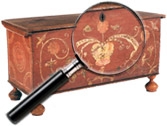|
|
John Lawrence Sullivan (1858 to 1918)
John Lawrence Sullivan (1858 to 1918) is generally agreed by boxing historians to be the first Heavyweight Champion of the modern era. He was the last bare-knuckles or London Prize Ring Rules-style champion, but later fought with gloves according to the Queensberry Rules, which made him the link between old style and modern fighting. Nicknamed the “Boston Strong Boy,” he was born in the Roxbury district of Boston [...] Click here to continue reading.
Newell Convers Wyeth (1882 to 1945)
N.C. Wyeth was born Newell Convers Wyeth on October 22, 1882 in Needham, Massachusetts, the oldest of four boys, who spent their young lives outdoors doing farm chores, hunting, fishing, or exploring the countryside. N.C. displayed an early talent for art, encouraged by his mother, and by twelve, he was producing quality watercolors. After drafting courses at the Mechanics Arts School, he went on to study illustration art [...] Click here to continue reading.
Sitting Bull, Sioux Chief (circa 1831 to 1890)
Sitting Bull, the man who would later become the Hunkpapa Sioux chief, was born in South Dakota, near the Grand River. His Lakota name was Tatanka-Iyotanka. In his thirties, he began to build his reputation as a warrior, leading war parties in Red Cloud’s War against a number of Dakota Territory forts. Although the U.S. negotiated with the Sioux in order to end the war and [...] Click here to continue reading.
Elijah Pierce (1892 to 1984)
Elijah Pierce was born on March 5, 1892 on a Mississippi farm, the son of a former slave. After receiving a pocketknife from his father, Elijah began carving. It might not have amounted to much without the guidance of his uncle, Lewis Wallace, who helped him learn the basics, like choosing the right kind of wood for a project. By the age of seven, he was carving small animals [...] Click here to continue reading.
McDonald’s Corporation
Maurice and Richard (Mac and Dick) McDonald opened a drive-in restaurant in San Bernardino, California, in 1937. In 1948, the brothers moved away from the traditional carhop operation of that era, going to a model that resembles today’s fast food restaurants, complete with a limited menu and premiums for children. The key to their success was the implementation of the assembly line-style operation that fast food restaurants are known for – a [...] Click here to continue reading.
The Battleship Maine
Construction of the U.S.S. Maine was authorized in August of 1886, and she was launched in 1889 and commissioned in 1895. After several years spent patrolling the East Coast and Caribbean, orders sent the Maine and her crew to Cuba in response to continued civil unrest on the island.
The photograph above is a 1896 image of the ship framed in a sheet iron frame made from remnants of [...] Click here to continue reading.
Frederick Maxfield Parrish (1870 to 1966)
Frederick Maxfield Parrish was born July 25, 1870 in Philadelphia to Stephen Parrish, an American artist famous for his landscapes, illustrations and engravings and his wife Elizabeth Bancroft Parrish. It’s not surprising that, finding himself surrounded by the tools of his father’s trade, that Frederick (he would begin to use Maxfield as his name later in life) would begin to draw to amuse himself. Around 1881, the Parrish [...] Click here to continue reading.
The Marly Horses
“Marly Horses,” paired sculptures also sometimes known as “horse tamers,” or just “horses restrained by grooms,” have their origins in France, probably by way of ancient Rome. Since the early days of Rome, a pair of sculptures, each of a man with a horse, have been on Quirinal Hill in the city. The spirited horses and the men seeking to control them are a discourse on power that has appealed to [...] Click here to continue reading.
Coca-Cola
Dr. John Stith Pemberton (1831 to 1888), an Atlanta pharmacist, invented Coca-Cola in 1886. A year earlier, he had introduced an alcoholic beverage called “Pemberton’s French wine coca”, but the temperance movement was then gathering momentum in the United States, prompting him to develop an alcohol-free product. Pemberton mixed a combination of lime, cinnamon, coca leaves, and kola nuts to make the famous beverage. When Coca-Cola was first introduced, the syrup was mixed [...] Click here to continue reading.
Hires Root Beer
While traveling in 1875, Charles E. Hires, a Philadelphia pharmacist, first tasted root beer. Root beer, traditionally made with sassafras, was a popular “small beer” or low-alcoholic drink in the colonial era, and was becoming popular in an alcohol-free format. While root beer has a long history, it has a wide range of recipes that call for everything from birch bark to vanilla, molasses to juniper berries, so Hires set out [...] Click here to continue reading.
|
Recent Articles
- Charles Alfred Meurer – American Artist & Tromp L’Oeil Artist
- Sendak, Maurice – American Artist & Writer
- Godie, Lee – American Artist
- Davis, Vestie – American Artist
- Bartlett, Morton – American Artist
- Mackintosh, Dwight – American Artist
- Evans, Minnie Jones – African-American Artist
- Mumma, Ed (Mr. Eddy) – American Artist
- Nice, Don – American Artist
- Savitsky, John (Jack) – American Artist
- Gordon, Harold Theodore (Ted) – American Artist
- Dial, Thornton – African-American Artist
- Doyle Sam – American Artist
- Johnson, Lester Frederick – American Artist
- Finster, Howard – American Artist
|
|
